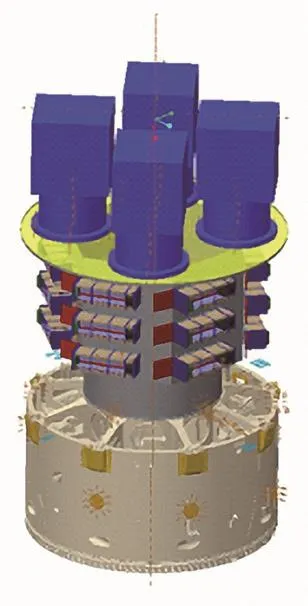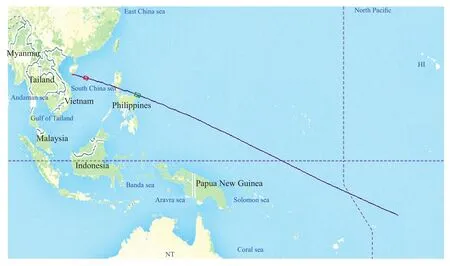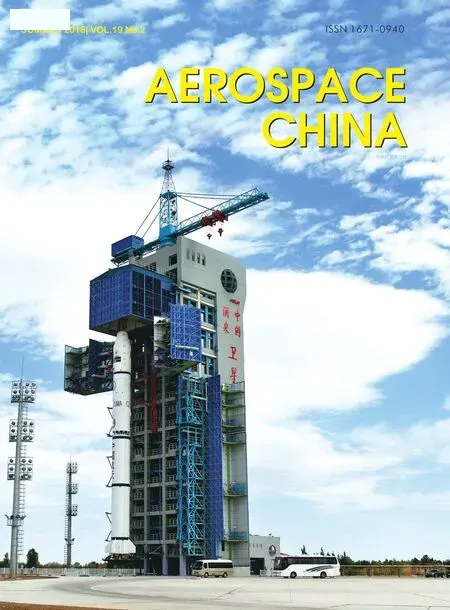LM-11SL: A Sea-Launched Carrier Rocket for Small Satellites and Its Launch Service
2018-02-20SHANGHuiLIUBoMENGXiangWUZhenyuZHANGYanlingZHANGFeiting
SHANG Hui, LIU Bo, MENG Xiang, WU Zhenyu, ZHANG Yanling, ZHANG Feiting
1 China Academy of Launch Vehicle Technology, Beijing 100076
2 China Great Wall Industry Corporation, Beijing 100054
Abstract: Following the successful maiden flight of the Long March 11 (LM-11) launch vehicle from the Jiuquan Satellite Launch Center in September 2015, the first sea-launched carrier rocket dedicated to provide a launch service for small satellites and their constellations, the Long March 11 Sea Launch (LM-11SL) has been under development by the China Academy of Launch Vehicle Technology (CALT) and the China Great Wall Industry Corporation (CGWIC). It is planned to commence launch service in 2018. Based on the LM-11, a land-launched four-staged solid launch vehicle which has entered the market and accomplished launch missions for several small satellites in the past 3 years, the newly adopted sea launch technology enables transport and launch of LM-11SL from maritime ships, providing flexible launch location selection.
Key words: LM-11SL, sea launch, launch vehicle, launch service, LM-11
1 DEVELOPMENT BACKGROUND
Over the past few years, the global small satellite industry has been developing rapidly, which has lead to a high demand of affordable, reliable and quick access to space, in particular,for the deployment of small satellite constellations. Meanwhile,small satellite commercial launch services have become a new segment in the international market.
In order to match the launch requirements from this market segment, the China Academy of Launch Vehicle Technology(CALT) and the China Great Wall Industry Corporation (CGWIC) had proposed a new launch service for small satellites,based on the Long March 11 (LM-11) launch vehicle, in 2015.
After this land-launched four-staged solid launch vehicle successfully accomplished launch missions over the last 3 years for several small satellites, a new technology of marine launch was developed which enables the launch vehicle transport and launch from maritime ships and enabling the launch location to be flexibly chosen. Based on this, the first dedicated sealaunched carrier rocket for small satellites and their constellations, the Long March 11 Sea Launch (LM-11SL) is being developed by CALT and is planned to commence launch services in the near future.
2 LAUNCH VEHICLE
LM-11SL adopts a four-stage configuration with a length of 20.8 m, a lift-off mass of 57 t and a maximum diameter of 2 m,as shown in Figure 1. It shares the same flight vehicle hardware with LM-11 that is launched from inland launch sites in China,the differences between the two types are all from the way of launching.
LM-11SL consists of the following major subsystems: vehicle structure, propulsion system, control system, telemetry system and self-destruction system.
2.1 Vehicle Structure
As shown in Figure 2, the vehicle structure mainly comprises payload fairing, spacecraft adapter, vehicle equipment compartment, inter-stage sections, tail section, separation structures and mechanisms within the different stages, as well as the electrical cable, covers etc.

Figure 1 LM-11SL launch vehicle
2.2 Propulsion System
For the propulsion system, solid motors are adopted for all four stages as the main power, while reaction control systems are adopted.
2.3 Control System
The control system is mainly comprised of the navigation and guidance system, attitude control system, integrated electronic system as well as a test launch and control system.

Figure 2 Structure of LM-11SL
The navigation and guidance system adopts a system based on a combination of laser strap-down IMU and satellite navigation. The attitude control system adopts a three-channel digital design. The test launch and control system utilizes a combination of ground tests and onboard tests.
2.4 Telemetry System
The telemetry system implements a TT&C system based on both ground stations and satellite relay.
2.5 Range Safe System
During flight, the range safe system will constantly monitor key functions. If any malfunction in accordance with predetermined conditions occurs, the system will send out a self-destruction instruction activating the self-destruction mechanisms.
3 LAUNCH ABILITY
Due to the heritage of the LM-11 and the newly adopted sea launch technology that enables transport and launch from maritime ships providing flexible launch location selection, LM-11SL is capable of sending payloads into low Earth orbits with a wide range of altitudes and all inclinations, conventionally circular orbits from 200 km to 1000 km, from equatorial to sun synchronous.
3.1 Launch Capacity
The standard launch capacity of LM-11SL is 620 kg for 500 km Equatorial Earth Orbit (EEO) and 430 kg for 500 km Sun Synchronous Orbit (SSO).

Figure 3 Launch capacity for circular orbits of different inclinations
For circular orbits with altitudes ranging from 200 km to 1000 km, the payload capability is presented in Figure 3.
LM-11SL is also capable for elliptical orbit missions. These launch capacities can be provided by CALT when required by customers.

Table 1 Orbit injection accuracy
3.2 Orbit Injection Accuracy and Spacecraft Attitude Adjustment Accuracy
The orbit injection accuracies (under 3s accuracy requirement) of LM-11SL are shown in Table 1.
The attitude adjustment for spacecraft of LM-11SL before SC/LV separation can be provided when demanded by the user.The angular deviations (3s) of roll, pitch and yaw are all less than 2°, and corresponding angular velocity deviations (3s) are also less than 2°/s.
3.3 Fairing Envelop and Payload Interface
Two types of fairing including one with an outer diameter of 1.6 m (recommended for most users) and the one with an outer diameter of 2.0 m are available for different missions.
The payload envelope of 1.6 m fairing and 2.0 m fairing are shown in Figure 4. The length of the envelope cylindrical section can be adjusted according to mission requirements if needed.

Figure 4 Fairing envelope
The top end of the fairing is radio transparent, and radiotransparent windows can also be equipped on the cylindrical section according to mission requirements.
Type 660 standard SC/LV interface with clamp band is available for satellites typically with a mass of over 200 kg and acting as the main payload (Minisats). For smaller satellites, other types of mechanical interfaces including CubeSat deployers, light bands, point-joints and so on are available as options.
4 LAUNCH OPERATION AND FLIGHT SEQUENCE
4.1 Launch Operation
After assembly, testing,mating with payloads (see Figure 5)fairing encapsulation is conducted in the assembly building. The LM-11SL is then hoisted onto a launch truck and transferred to the sea port, where the launch truck goes onboard the launch ship and the ship sets sail. As shown in Figure 6, after arriving at the launch location on the sea, LM-11SL is erected. Controlled and monitored by a TT&C ship, LM-11SL lifts off and deploys the payloads into their target orbits.

Figure 5 Payload mating operation in assembly building

Figure 6 Sea launch operations at launch location
Excluding the duration of transportation by launch ship to the launch location, the standard duration of the launch operation is within 7 days.
4.2 Flight Sequence
A typical flight sequence of LM-11SL is shown in Figure 7.
5 A LOW INCLINATION MUTI-SATELLITE LAUNCH SERVICE EXAMPLE
In order to demonstrate how the LM-11SL would serve for small satellites, an example launch service solution is described in this chapter, under the assumption that an order from a customer is to send a cluster of small satellites into a near equatorial orbit with a 15° inclination.
5.1 Launch Demand
Assuming the customer payloads are 4 Microsats with a 75 kg launch mass each and 18 3U-CubeSats with an 8 kg launch mass each (including a 3U deployer for each CubeSat).
The target orbit is a circular orbit with 500 km altitude and 15° inclination whose orbit plane is near the Earth equatorial plane.
5.2 Launch Solution
After mission analysis, the standard type 660 SC/LV interfaces are chosen for the 4 Microsats and a mounting structure(Shown in Figure 8) are designed which enables the multisatellite launch, as well as the universal multi-satellite separation controller which is an optional part of LM-11SL.
The total launch mass of 4 Microsats with their SC/LV interfaces is summed up to 360 kg, and the total launch mass of 18 3U-CubeSates and their deployers is 144 kg. The total launch mass is therefore 504 kg.

Figure 7 Flight sequence of LM-11SL

Figure 8 Mounting structure for multi-satellite launch
The launch capacity of the LM-11SL to the target orbit is 600 kg. Considering the mass of the mounting structure and other auxiliaries for payloads, the launch capacity is sufficient for the mission.
Taking orbit inclination, drop zones, convenience of supply and so on into consideration, and a theoretically feasible launch location is preliminary chosen at the sea close to south tip of Hainan island of China. Figure 9 shows the flight trajectory (in blue line) and drop zones (areas in red rectangles) on the map.
6 FLIGHT MISSIONS OF LM-11 AND LM-11SL
The flight records and flight plans of LM-11 and LM-11SL are shown in Table 2.
For previous 4 launch missions of LM-11, the launch vehicle proved its high precision of orbit injections, as shown in Table 3.
Figure10 shows the previous LM-11 F3 launch mission and the CubeSat of Kepler launched in this mission, which is the first international payload of LM-11.

Figure 9 Preliminary theoretical flight trajectory and drop zones of example mission
7 LAUNCH SERVICE
The LM-11SL, is mainly used for launch services of sending small satellites into wide range of target orbits. For the launch requirements in the future, CALT has already prepared several flight vehicles available for both LM-11SL and LM-11 launch vehicles for customer missions by batch production and is looking for requirements from global commercial customers.
The launch service for an international customer is mainly provided by cooperation of CALT and CGWIC.
CALT is the largest comprehensive entity for research, design, development, manufacture and testing of launch vehicles in China. Established in 1957, CALT is the first academy and cradle of the Chinese space industry. Since the first satellite launch in 1970, CALT has conducted over 170 launch missions with Long March launch vehicles and is very experienced in mission analysis, planning and launch operations.To meet the requirements of various launch missions, CALT has developed a family of Long March launch vehicles, which can send payloads into different orbits based upon proven flight launch vehicles.

Figure 10 LM-11 F3 Mission and CubeSat of Kepler

Table 2 Flight records and flight plans of LM-11 and LM-11SL

Table 3 Orbit injection deviation parameters of LM-11 F1-F3
CGWIC, as an exclusive commercial organization authorized by the Chinese Government to offer Long March launch services to the international market, provides not only dedicated but also the piggyback launch services to international customers. By the end of May 2018,CGWIC had conducted 15 piggyback launches of small satellites for international customers.
In a typical international launch services program, as shown in Figure 11, CGWIC will act as a prime contractor to work with its subcontractors. CALT will be the subcontractor of CGWIC for launch vehicles. CGWIC and CALT are all subordinated to China Aerospace Science and Technology Corporation (CASC). China Satellite Launch and Tracking Control General (CLTC), another important subcontractor of CGWIC for launch operations and TT&C, will work with CGWIC and CALT to conduct the launch in China and provide TT&C services.
In order to better meet the launch requirements form the small satellite industry, CGWIC with the support of CALT,develops and provides a customized “Long March Express”launch services solution for small satellites, including the dedicated launch, piggyback launch and cluster launch, based on the LM-11SL/LM-11.
Furthermore, with the strong support from the Chinese government and the booming commercial space business environment in China, CGWIC can also facilitate its customer with the financing and insurance facilities.
8 CONCLUSION
On the basis of the technology, experience and flight heritage of previous Long March launch vehicles, the LM-11SL is being developed. As the first sea-launched launch vehicle dedicated developed for small satellites and their constellations, the LM-11SL will provide a flexible, reliable and economical launch service for the global small satellite industry.

Figure 11 Organization of Long March launch services
杂志排行
Aerospace China的其它文章
- 2017 LM-5 Launch Failure Investigation Finished
- China Launches the 32nd Satellite of the BeiDou Navigation System
- China-Egypt Cooperation for Egyptian Space City Project Formally Initiated
- China and Saudi Arabia Jointly Unveil Lunar Images
- International Cooperation on the Chinese Space Station Officially Initiated
- Promoting Space Internationalization Development Based on QIAN Xuesen Think Tank
